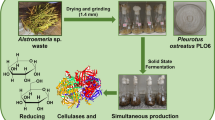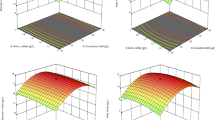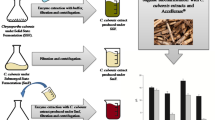Abstract
We report here the production of pure (R,R)-2,3-butanediol (2,3-BDO) isomer by the non-pathogenic Paenibacillus polymyxa ICGEB2008 using lignocellulosic hydrolysate as substrate. Experimental design based on Plackett-Burman resulted in identification of Mn and K as most crucial salt elements along with the yeast extract for 2,3-BDO production. Further experiments using Box-Behnken design indicated that both KCl and yeast extract together had major impact on 2,3-BDO production. Optimized medium resulted in 2,3-BDO production with 2.3-fold higher maximum volumetric productivity (2.01 g/L/h) and similar yield (0.33 g/g sugar) as compared to rich yeast extract-peptone-dextrose medium in the bioreactor studies. Considering that the balance substrate was channeled towards ethanol, carbon recovery was close to theoretical yield between the two solvents, i.e., 2,3-BDO and ethanol. Biomass hydrolysate and corn-steep liquor was used further to produce 2,3-BDO without impacting its yield. In addition, 2,3-BDO was also produced via simultaneous saccharification and fermentation, signifying robustness of the strain.





Similar content being viewed by others
References
Adlakha N, Kushwaha H, Rajagopal R, Yazdani SS (2013) Draft genome sequence of the Paenibacillus sp. strain ICGEB2008 (MTCC 5639) isolated from the gut of Helicoverpa armigera. Genome Announc 1(1):e00026–12
Adlakha N, Sawant S, Anil A, Lali A, Yazdani SS (2012) Specific fusion of β-1,4-endoglucanase and β-1,4-glucosidase enhances cellulolytic activity and helps in channeling of intermediates. Appl Environ Microbiol 78:7447
Adlakha N, Rajagopal R, Kumar S, Reddy VS, Yazdani SS (2011) Synthesis and characterization of chimeric proteins based on cellulase and xylanase from an insect gut bacterium. Appl Environ Microbiol 77:4859–4866
Amartey S, Jeffries TW (1994) Comparison of corn steep liquor with other nutrients in the fermentation of D-xylose by Pichia stipitis CBS 6054. Biotechnol Lett 16:211–214
Anvari M, Motlagh RS (2011) Enhancement of 2,3-butanediol production by Klebsiella oxytoca PTCC 1402. J Biomed Biotechnol 2011:1–7
Celińska E, Grajek W (2009) Biotechnological production of 2,3-butanediol–current state and prospects. Biotechnol Adv 27:715–725
Cheng KK, Liu Q, Zhang JA, Li JP, Xu JM, Wang GH (2010) Improved 2,3-butanediol production from corn cob acid hydrolysate by fed-batch fermentation using Klebsiella oxytoca. Process Biochem 45:613–617
Das SP, Ghosh A, Gupta A, Goyal A, Das D (2013) Lignocellulosic fermentation of wild grass employing recombinant hydrolytic enzymes and fermentative microbes with effective bioethanol recovery. Biomed Res Int 2013:1–13
El-Leithy MA, Ibrahim AY, El-Marsafy MK, Kassim SA (1973) Production of bacterial amylase on some commercial materials. Zentralbl Bakteriol Parasitenkd Infektionskr Hyg 128:473–482
Francis F, Sabu A, Nampoothiri KM, Ramachandran S, Ghosh S, Szakacs G, Pandey A (2003) Use of response surface methodology for optimizing process parameters for the production of α-amylase by Aspergillus oryzae. Biochem Eng J 15:107–115
Gao J, Xu H, Li QJ, Feng XH, Li S (2010) Optimization of medium for one-step fermentation of inulin extract from Jerusalem artichoke tubers using Paenibacillus polymyxa ZJ-9 to produce R,R-2,3-butanediol. Bioresour Technol 101:7087–7093
Guo WQ, Ren NQ, Wang XJ, Xiang WS, Ding J, You Y, Liu BF (2009) Optimization of culture conditions for hydrogen production by Ethanoligenens harbinense B49 using response surface methodology. Bioresour Technol 100:1192–1196
Gupta BS, Hashim MA, Ramachandran KB, Gupta IS, Cui ZF (2005) The effect of gas sparging in cross-flow microfiltration of 2,3-butanediol fermentation broth. Eng Life Sci 5:54–57
Hespell RB (1996) Fermentation of xylan, cornfiber, or sugars to acetoin and butanediol by Bacillus polymyxa strains. Curr Microbiol 32:291–296
Horn SJ, Kolstad GV, Westereng B, Eijsink VGH (2012) Novel enzymes for the degradation of cellulose. Biotechnol Biofuels 5:45
Ji XJ, Huang H, Ouyang P (2011) Microbial 2,3-butanediol production: a state-of-the-art review. Biotechnol Adv 29:351–364
Jurchescu IM, Hamann J, Zhou X, Ortmann T, Kuenz A, Prüße U, Lang S (2013) Enhanced 2,3-butanediol production in fed-batch cultures of free and immobilized Bacillus licheniformis DSM 8785. Appl Microbiol Biotechnol 97:6715–6723
Kadar ZS, Azengyel ZS, Reczey K (2004) Simultaneous saccharification and fermentation (SSF) of industrial wastes for the production of ethanol. Ind Crop Prod 20:103–110
Kim SJ, Lee HK, Yim JH (2008) Statistical optimization of medium components for the production of prodigiosin by Hahella chejuensis KCTC 2396. J Microbiol Biotechnol 18:1903–1907
Kishan G, Gopalakannan P, Muthukumaran C, Thirumalai Muthukumaresan K, Dharmendira M, Tamilarasan K (2013) Statistical optimization of critical medium components for lipase production from Yarrowia lipolytica (MTCC 35). Genet Eng Biotechnol 11:111–116
Kumar P, Satyanarayana T (2007) Optimization of culture variables for improving glucoamylase production by alginate-entrapped Thermomucor indicae-seudaticae using statistical methods. Bioresour Technol 98:1252–1259
Lali AM, Nagwekar PD, Varavadekar JS, Wadekar PC, Gujarathi SS, Valte RD, Birhade SH, Odaneth AA (2010) Method for production of fermentable sugars from biomass (PCT/IN2010/000355)
Li D, Dai JY, Xiu ZL (2010) A novel strategy for integrated utilization of Jerusalem artichoke stalk and tuber for production of 2,3-butanediol by Klebsiella pneumoniae. Bioresour Technol 101:8342–8347
Mishra A, Kumar S, Kumar S (2008) Application of Box-Behnken experimental design for optimization of laccase production by Coriolus versicolor MTCC138 in solid-state fermentation. J Sci Ind Res 67:1098–1107
Munjal N, Mattam AJ, Pramanik D, Srivastava PS, Yazdani SS (2012) Modulation of endogenous pathways enhances bioethanol yield and productivity in Escherichia coli. Microb Cell Fact 11:145
Piuri M, Sanchez-Rivas C, Ruzal SM (1998) A novel antimicrobial activity of a Paenibacillus polymyxa strain isolated from regional fermented sausages. Lett Appl Microbiol 27:9–13
Prakash G, Srivastava AK (2005) Statistical media optimization for cell growth and azadirachtin production in Azadirachta indica (A. Juss) suspension cultures. Process Biochem 40:3795–3800
Syu MJ (2001) Biological production of 2,3-butanediol. Appl Microbiol Biotechnol 55:10–18
Wang AL, Wang Y, Jiang TY, Li LX, Ma CQ, Xu P (2010) Production of 2,3-butanediol from corn cob molasses, a waste by-product in xylitol production. Appl Microbiol Biotechnol 87:965–970
Zeng AP, Biebl H, Deckwer WD (1990) Effect of pH and acetic acid on growth and 2,3-butanediol production of Enterobacter aerogenes in continuous culture. Appl Microbiol Biotech 33:485–489
Acknowledgments
Authors would like to thank Prof. Arvind Lali for providing pre-treated biomass and Advanced Enzymes for providing cellulolytic enzymes. This work was supported by the grant from Department of Biotechnology, Govt. of India.
Author information
Authors and Affiliations
Corresponding author
Electronic supplementary material
Below is the link to the electronic supplementary material.
Rights and permissions
About this article
Cite this article
Adlakha, N., Yazdani, S.S. Efficient production of (R,R)-2,3-butanediol from cellulosic hydrolysate using Paenibacillus polymyxa ICGEB2008. J Ind Microbiol Biotechnol 42, 21–28 (2015). https://doi.org/10.1007/s10295-014-1542-0
Received:
Accepted:
Published:
Issue Date:
DOI: https://doi.org/10.1007/s10295-014-1542-0




